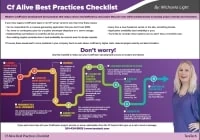Geoff Bowers talks about “Secrets from the folks who make the official Lucee CFML Docker images” in this episode of ColdFusion Alive podcast with host Michaela Light.
Show notes
- Secrets from the folks who make the official Lucee Docker images
- Treat your servers like cattle and not pets – throw old server away and instantiate a new clean one
- Much faster server spin up (seconds)
- Much easier server setup and programmable install
- Continuous delivery ⇒ more confidence at rolling out code changes
- Dev → stage → production
- CF DevOps Tips
- Version control of server instances
- No more running server upgrades or patches for CF, the JVM, the OS, the DB – pull a new Docker image and create a fresh server
- Programmatically server config
- Orchestration of server clusters
- High availability by having 2+ containers in different data centers (on AWS)
- Checkbox for MySQL replication (and read replicas)
- “Infrastructure on demand”
- Paying by the minute (auto shut down staging server at night and weekends to save 50% on your AWS costs
- Security scanning of docker images
- Converting to Docker
- No writing files locally → CDN or other shared location
- 5 day convert to Docker Daemon consulting
- Why Serverless is cool.
- Spaghetti server architecture
- Lasagna layers
- Ravioli micro services
- What new apps are you building in Lucee CFML
- University private video hosting
- AWS transcoding service
- Queue + auto scaling of servers
- 16 TB of data
- High availability infrastructure
- Tricks to migrating legacy ACF to Lucee CFML
- The app that would never die
- How he started WebDU and why they consciously chose to close it after a 10 year run.
- What did you enjoy at CFObjective?
- How did you come up with the name Daemon and @modius?
- Daemon (is pronounced Demon in the US) like Encyclopaedia / Haemoglobin
- Why are you proud to use CFML?
- WWIT to make CF more alive this year?
Mentioned in this episode
-
Lucee CFML
-
Tomcat
-
Docker
-
Containers
-
Chef
-
Ansible
-
Vagrant
-
Debian Linux
-
OpenJDK
-
Alpine Linux – very lean (5MB)
-
Microsoft Windows Docker containers
-
Farcry CF CMS
-
Patrick Quinn episode
-
AWS
-
Park My Cloud
-
DockerHub
-
Brian Klass AWS episode
-
AWS transcoding service
-
Amazon S3
-
Amazon EC2
-
Azure
-
Digital Ocean
-
Brad Wood
Listen to the Audio
Bio
Geoff Bowers
Geoff Bowers is a CEO of Daemon in Sydney Australia for 22 years so far and a President of Lucee Association (LAS). He has ran WebDU conference for 10 years.
Links
Interview transcript
Michael: I'm here with Geoff Bower from Demon. [If I'm saying that right. He gave me extensive lessons on how to pronounce it.] And we're going to be talking about secrets from the folks who make the official Lucee CFML Docker images. So as well as that, we’ll look at some ColdFusion dev ups tips. Why is he thinks Servulous is so cool these days, and some of the neat apps he's building with Lucee CFML with his team there down in Australia. And also look at tricks they use on migrating legacy Adobe ColdFusion to Lucee. And we’ll also do a little bit of chat about web [inaudible] [00:40], and a few other interesting things. So welcome Geoff.
Geoff: hi there
Michael: And just in case you don't know, he’s C.E.O. of Demon, has been around for like 22 years, been doing ColdFusion forever, or at least since version one.
Geoff: Seems like forever. Now probably since version… I think might be version was is three and a half I can’t remember.
Michael: In 97, was three and a half?
Geoff: Nearly three and a half. 97 is sort of the time frame.
Michael: Yeah, and he's also president of LAS; the Lucy Association Switzerland. So he's the …that's where the buck stops as they say in America.
Geoff: It’s where the buck stops, yeah.
Michael: Yeah, so you guys there make all the official Lucee Docker images. Tell us about that, and why that matters to people listening.
Geoff: Well, I think the first thing to say is in ter
Read more
And to continue learning how to make your ColdFusion apps more modern and alive, I encourage you to download our free ColdFusion Alive Best Practices Checklist.
Because… perhaps you are responsible for a mission-critical or revenue-generating CF application that you don’t trust 100%, where implementing new features is a painful ad-hoc process with slow turnaround even for simple requests.
What if you have no contingency plan for a sudden developer departure or a server outage? Perhaps every time a new freelancer works on your site, something breaks. Or your application availability, security, and reliability are poor.
And if you are depending on ColdFusion for your job, then you can’t afford to let your CF development methods die on the vine.
You’re making a high-stakes bet that everything is going to be OK using the same old app creation ways in that one language — forever.
All it would take is for your fellow CF developer to quit or for your CIO to decide to leave the (falsely) perceived sinking ship of CFML and you could lose everything—your project, your hard-won CF skills, and possibly even your job.
Luckily, there are a number of simple, logical steps you can take now to protect yourself from these obvious risks.
No Brainer ColdFusion Best Practices to Ensure You Thrive No Matter What Happens Next
ColdFusion Alive Best Practices Checklist
Modern ColdFusion development best practices that reduce stress, inefficiency, project lifecycle costs while simultaneously increasing project velocity and innovation.
√ Easily create a consistent server architecture across development, testing, and production
√ A modern test environment to prevent bugs from spreading
√ Automated continuous integration tools that work well with CF
√ A portable development environment baked into your codebase… for free!
Learn about these and many more strategies in our free ColdFusion Alive Best Practices Checklist.

